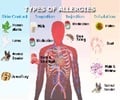Children and adults who are referred for patch testing of allergens are equally likely to have allergic contact dermatitis, but they have the tendency to react to different allergens, says a new study
Children and adults who are referred for patch testing of allergens are equally likely to have allergic contact dermatitis, but they have the tendency to react to different allergens, says a new study
The study report in the Archives of Dermatology, one of the JAMA/Archives journals, highlights that skin reactions to allergens are common among children.Such reactions can occur both on areas of the skin that come in direct contact with an allergen (contact dermatitis), and on areas that are not directly affected (atopic dermatitis).
Children suspected of contact dermatitis are often referred for patch testing, in which skin is exposed to various allergens affixed to a plaster tape to identify which cause a reaction.
During the study, Dr. Kathryn A. Zug and colleagues at of Dartmouth-Hitchcock Medical Center, Lebanon, analysed results from 391 children age 18 and younger, who underwent patch testing between 2001 and 2004.
The researchers compared results of the paediatric population to a group of 9,670 adults, who were tested during the same time period.
The team observed that children as well as adults tested positive for at least one allergen at approximately the same rate.
Advertisement
According to them, some children reacted to supplemental allergens not included in common patch test series (15 percent), or in commercially available tests (39 percent).
Advertisement
"Patch testing in children suspected of having allergic contact dermatitis is a valuable endeavour. Despite their limited back size, an expanded allergen series helps to identify important positive relevant allergens. Allergen concentration does not need modification for testing in children," the authors write.
"The top 45 allergens with the most frequent positive and relevant reactions reported in this study should serve as a guide to patch testing in children suspected of having allergic contact dermatitis in North America. Including supplemental allergens to the patch test materials based on clinical suspicion is also useful in some patients," they add.
Source-ANI
RAS/SK









